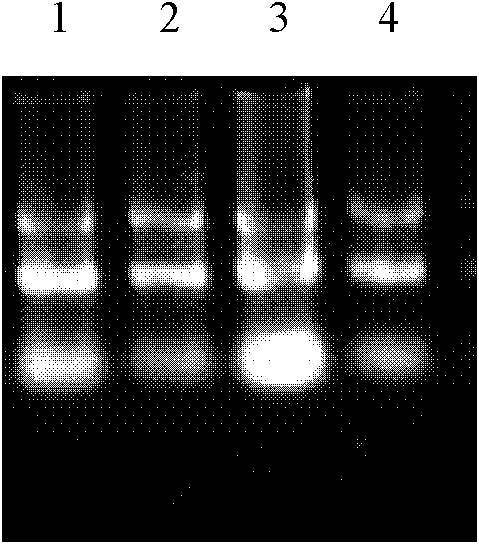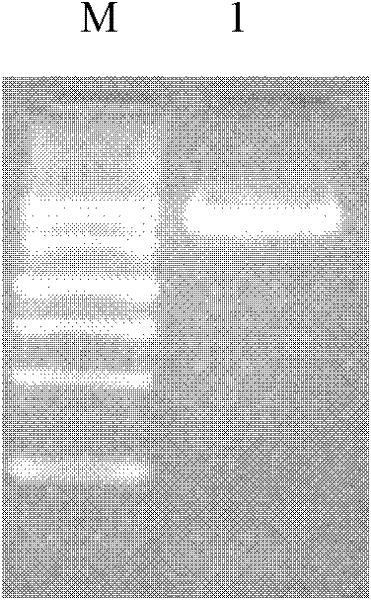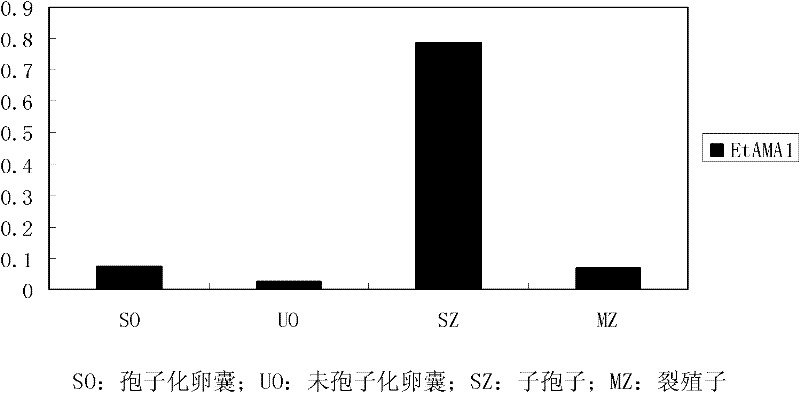Eimeria tenella apical membrane antigen 1 (AMA 1) gene and application thereof
A technology of Eimeria tenella and tenderness, applied in the fields of application, gene therapy, genetic engineering, etc., which can solve the problems that there is no research report on Eimeria tenella AMA1 gene
- Summary
- Abstract
- Description
- Claims
- Application Information
AI Technical Summary
Problems solved by technology
Method used
Image
Examples
Embodiment 1
[0048] Example 1 Cloning and analysis of full-length cDNA of Eimeria tenella AMA1 gene
[0049] Using the difference between the Eimeria tenella sporozoite gene expression library and the merozoite gene expression library, EST sequences highly expressed in the sporozoite stage and merozoite stage were obtained, and the EST sequences with high homology to the acrosomal membrane protein were selected The sequence BG589 was used to amplify the full-length gene, and the amplified full-length gene was the Eimeria tenella acrosomal membrane antigen-1 gene, named EtAMA1.
[0050] The full-length cDNA of the EtAMA1 gene was amplified by RACE technology, and the specific steps were as follows:
[0051] 1. Collection of Eimeria tenella sporozoites
[0052] 1.1 Collection and sporulation of Eimeria tenella unsporulated oocysts
[0053] Take the sporulated oocysts of Eimeria tenella stored at 4°C, centrifuge at 3000r / min for 10min, add an appropriate amount of distilled water to the pre...
Embodiment 2
[0076] Example 2 Analysis of expression differences of EtAMA1 gene in different developmental stages of Eimeria tenella
[0077]The total RNA of four developmental stages of Eimeria tenella (spored oocysts, unsporulated oocysts, sporozoites, and second-generation merozoites) were extracted, and the unsporulated eggs of Eimeria tenella The first strand of cDNA of cysts, sporulated oocysts, sporozoites, and second-generation merozoites was used as a template, and the housekeeping gene 18S rRNA was selected as an internal reference by real-time fluorescent quantitative PCR to observe the differences of EtAMA1 gene in Eimeria tenella. mRNA transcription in developmental stage worms. The experimental results show that the EtAMA1 gene is highly expressed in the sporozoite development stage of Eimeria tenella (see image 3 ). Table 3 is the real-time fluorescence quantitative PCR amplification primer sequence.
[0078] Table 3 real-time quantitative PCR amplification primer sequen...
Embodiment 3
[0080] The prokaryotic expression of embodiment 3EtAMA1 gene
[0081] 1. Extraction of prokaryotic expression vector pGEX-6P-1 plasmid
[0082] The plasmid DNA miniprep kit was used to extract the empty vector plasmid pGEX-6P-1 and the plasmid pGEM-T-BG589 containing the full-length sequence of the AMA1 gene, and stored at -20°C for future use.
[0083] 2. Cloning of the EtAMA1 gene sequence containing restriction sites
[0084] Sequence analysis was performed on the full-length sequence of the AMA1 gene. After removing the signal peptide and the transmembrane region of the AMA1 gene, primers were designed for the sequence of the extracellular region for sequence amplification. The upstream and downstream primers were SPA1 and SPA2 respectively (Table 4). BamH I and EcoRI were added to the primers, and the cloning plasmid pGEM-T-BG589 containing the full-length sequence of the AMA1 gene was used as a template to amplify the expression sequence of the AMA1 gene by PCR, thereby...
PUM
| Property | Measurement | Unit |
|---|---|---|
| molecular weight | aaaaa | aaaaa |
Abstract
Description
Claims
Application Information
 Login to View More
Login to View More - R&D
- Intellectual Property
- Life Sciences
- Materials
- Tech Scout
- Unparalleled Data Quality
- Higher Quality Content
- 60% Fewer Hallucinations
Browse by: Latest US Patents, China's latest patents, Technical Efficacy Thesaurus, Application Domain, Technology Topic, Popular Technical Reports.
© 2025 PatSnap. All rights reserved.Legal|Privacy policy|Modern Slavery Act Transparency Statement|Sitemap|About US| Contact US: help@patsnap.com



